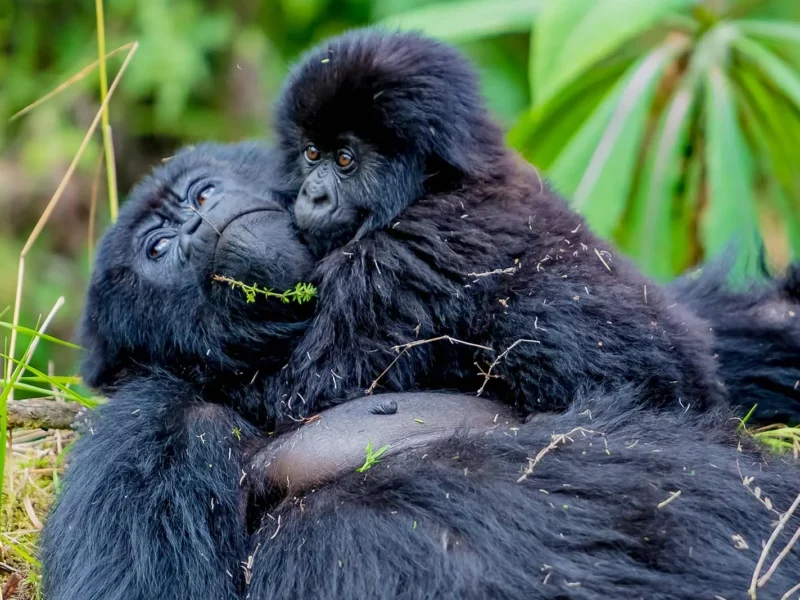What to Wear for a Gorilla Trekking Safari in Uganda
November 11, 2025
The Most Frequently Asked Questions About Gorilla Trekking (Answered)
November 17, 2025What to Wear for a Gorilla Trekking Safari in Uganda
Gorilla trekking in Uganda is one of the most thrilling wildlife experiences on earth a rare opportunity to walk through lush tropical forests in search of the majestic mountain gorillas. The experience is both humbling and unforgettable, but it also demands proper preparation, especially when it comes to what you wear. The right clothing will keep you comfortable, safe, and focused on the adventure rather than on scratches, rain, or insects.
If you’re planning a trip with a trusted safari company such as Terenga Safaris, they will help you organize every detail from securing your gorilla trekking permit to guiding you on what to pack and wear for the trek.
Why What You Wear Matters
Gorilla trekking takes place in dense rainforest terrain usually in Bwindi Impenetrable National Park or Mgahinga Gorilla National Park. Trails can be steep, muddy, and slippery, and the weather changes quickly. Proper clothing isn’t just about looking the part; it’s about protection, comfort, and safety. You’ll need to shield yourself from branches, insects, and unexpected downpours while keeping cool enough to hike for several hours.
What to Wear: A Head-to-Toe Guide
1. Choose Neutral, Earthy Colors
Opt for greens, browns, khakis, and greys. These blend with the forest environment and don’t attract unnecessary attention from wildlife. Avoid bright colors (like red or white) and camouflage patterns, which are not allowed in Ugandan parks as they’re reserved for military personnel.
2. Long-Sleeved Shirts
A lightweight, long-sleeved shirt made from breathable, quick-dry material is ideal. It keeps you cool while protecting your arms from stinging plants and insect bites. Layering is key mornings can be chilly, but it warms up quickly once you start trekking.
3. Long Trousers
Wear comfortable, long trekking pants that are lightweight but durable. They protect your legs from thorns, branches, and insects. Avoid jeans, as they become heavy and uncomfortable when wet. You can also tuck your pants into your socks to prevent ants or other insects from crawling up your legs.
4. Sturdy Hiking Boots
Your footwear can make or break your trekking experience. Choose waterproof hiking boots with good ankle support and strong grip. The trails are often muddy, especially after rain, so reliable boots are essential for stability and comfort. Make sure they’re well broken in before your trip to avoid blisters.
5. Comfortable Socks
Bring thick, moisture-wicking socks preferably hiking socks made of wool or synthetic blends. Carry an extra pair in your daypack in case the first gets wet.
6. Rain Jacket or Poncho
Rain is always a possibility in Uganda’s tropical forests, even in the “dry” season. Pack a light, waterproof rain jacket or poncho that can fit easily in your backpack. A jacket with a hood is best to keep you and your backpack dry.
7. Gloves
Yes gloves are very useful! Gardening or trekking gloves protect your hands when you grab vines or branches for support. They also prevent scratches and stings when moving through dense vegetation.
8. Hat and Sun Protection
A wide-brimmed hat or cap protects you from sun and light rain. Don’t forget sunscreen and insect repellent even in shaded forests, these are essentials.
9. Optional Extras
- Gaiters: Useful if you expect muddy conditions or want extra protection from insects.
- Trekking poles: Helpful for balance on steep or slippery trails.
- Light fleece or sweater: For cooler mornings and evenings at higher altitudes.
- Daypack: A small, waterproof backpack for your water, snacks, rain gear, and camera.
What Not to Wear
- Avoid brightly colored clothing — it can distract or alarm gorillas.
- Avoid camouflage patterns illegal for civilians in Uganda.
- Avoid shorts, sandals, or open shoes — they offer no protection against insects or undergrowth.
- Avoid strong perfumes or aftershaves — gorillas have sensitive noses.
The Role of Terenga Safaris
Planning a gorilla trekking safari can be complicated, but companies like Terenga Safaris make it simple and stress-free. They specialize in tailor-made Uganda safaris, including gorilla trekking in Bwindi and Mgahinga.
When you book through Terenga Safaris, they will:
- Secure your gorilla trekking permits in advance (required for every visitor).
- Arrange comfortable accommodation near the trekking site.
- Provide local guides and porters to assist you on the trek.
- Offer expert advice on what to pack and wear based on the season and trekking region.
- Handle transport and logistics so you can focus entirely on the experience.
Their local expertise ensures you get the most authentic and enjoyable adventure possible while supporting community and conservation efforts that protect Uganda’s endangered mountain gorillas.
Final Tips Before You Go
- Test your gear before the trip, especially boots and rain gear.
- Carry enough drinking water and light snacks for energy.
- Hire a porter it supports local communities and makes your trek easier.
- Respect the gorillas maintain a 7-meter distance, avoid flash photography, and follow all park rules.
- Stay calm and enjoy seeing gorillas in their natural habitat is an extraordinary, once-in-a-lifetime experience.
The best outfit for gorilla trekking in Uganda is practical, comfortable, and protective. Neutral-colored, long clothing, waterproof layers, and sturdy boots are essentials. And when it comes to organizing the experience, Terenga Safaris offers professional guidance, reliable logistics, and unforgettable adventures that bring you face-to-face with Uganda’s gentle giants.
So pack smart, dress right, and get ready your gorilla trekking adventure awaits in the heart of Uganda’s rainforests.



